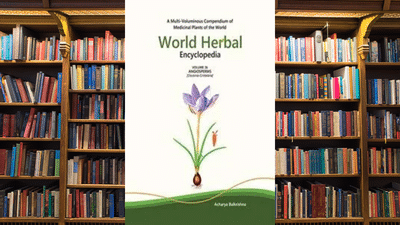
In an era when knowledge of medicinal plants is often fragmented, the monumental World Herbal Encyclopedia by Acharya Balkrishna stands as an audacious and commendable effort to weave together botanical, ethnomedical and healing-tradition strands from around the world into one reference compendium. Spanning 111 volumes, the work proudly presents itself as one of the largest modern undertakings in its domain—an encyclopaedic gesture that is, in many ways, its greatest strength.
From the outset the scale is dazzling: the first 102 volumes list medicinal plants alphabetically, followed by seven volumes devoted to the history of nine global medical systems and nearly a thousand healing practices; the final volume offers a commentary on the compilation process itself. As the introduction reveals, the work attempts to catalogue approximately 50,000 plant species and 7,500 genera, link them with some 1.2 million local names across 2,000 languages, and document more than 250,000 plant synonyms. With over 600,000 references ranging from ancient manuscripts to contemporary scientific reports, and a visual accompaniment of 35,000 botanical line-drawings and 30,000 paintings, this is not mere book-making—it is a declaration. If one were to choose the word “ambitious,” then this encyclopedia wears it unabashedly.
What succeeds particularly is the sheer comprehensiveness. For scholars of ethnobotany , conservationists tracking disappearing knowledge systems, and cultural historians mapping traditional medicines, this is a trove. Its visual richness makes it accessible - not just to academic users but to libraries, reference collections and serious enthusiasts. The decision to preserve not only plants but the healing practices of more than 2,000 tribal peoples, some 2,200 folk medicines and roughly 1,000 healing traditions adds a layer of urgency and value: these are the kinds of knowledge often at risk of being lost. In short: this is preservation with purpose.
The format also reflects thoughtful editorial design. Alphabetical listings ensure ease of reference, the distinct volumes for system history give structure, and the bridging volume on process gives context. To open a volume is to feel the weight of hundreds of years of healing lore, painted plants, nomenclatures inter-twined with world languages and wisdom traditions. For the user who is willing to leaf through its stacks, the reward is tangible.
While the work’s scale is a marvel, that grandeur also introduces challenges around academic verification. A number of entries lean heavily on traditional or oral sources, and the fact that much of the work is driven by a single author raises questions about the degree of external peer-review or taxonomic integration. The encyclopedia uses Sanskrit and Latin binomials side-by-side; while this signals a bridging of cultural knowledge, it also complicates its alignment with international taxonomic standards. For a botanist seeking to map species into mainstream academic frameworks, this might require supplementary cross-checking.
Another practical issue is accessibility. The distribution of complete sets appears limited, and many institutions may not yet hold the full 111-volume collection. While a web portal for the encyclopedia is being established and will help widen access, for now the physical heft of the volumes can be a barrier—both in terms of cost and storage. Thus, the audience for which the work is most read may remain somewhat niche.
Despite those minor drawbacks, the encyclopedia’s positive contribution far outweighs them. It serves as a massive archival resource, a safeguard for plant and healing-tradition knowledge, and a prompt for future scholarship. It is not, and does not claim to be, a clinical guide - nor should it be used as one - but that does not undermine its value. Instead it should be read as a gateway: a reference-library piece that opens many doors and invites further research.
In terms of tone and ambition the work is rare: to undertake a world-spanning herbal compendium in the 21st century is not modest. It is both bold and timely, given global interest in biodiversity, traditional medicine , and conservation. The World Herbal Encyclopedia may not fit neatly into conventional academic reference frameworks, but it plays a complementary and perhaps necessary role. Medicinal-plant scholarship, after all, can only benefit from broader canvases—especially ones that link culture, language, iconography and healing together.
In summary: if you are a librarian, researcher, cultural historian or conservationist, this is a landmark reference work you will want on your shelf. If you are a plant-enthusiast or curious about healing traditions, you will find yourself drawn across its volumes. And even though you may occasionally pause to cross-check a plant name or note the absence of classical botanical peer-review, you will still walk away with a sense of awe at the scope and intent of this encyclopaedia. In its ambition, visual appeal and preservation mission, Acharya Balkrishna’s World Herbal Encyclopedia delivers - quite impressively so.
-
Mouni Roy Recalls Harrowing Incident From Her Early Days In Bollywood: 'I Started Shaking...'

-
WPL 2026 Retention: Harmanpreet Kaur, Smriti Mandhana Retained, UP Release Deepti Sharma - Check Full List

-
IND vs AUS 4th T20I: Team India Edge Past Australia By 48 Runs At Gold Coast To Take 2-1 Lead In Series

-
Neil Bhatt & Aishwarya Sharma Heading For Divorce? Separation, Cheating Allegations & Everything Else You Need To Know

-
Rashmika Mandanna and Vijay Deverakonda’s wedding date revealed, its on.., destination is…
